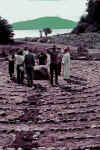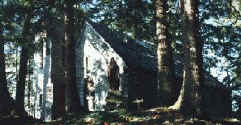click thumbnails for larger image. |
On June 29th and 30th, a host of volunteers gathered at the Shrine to build a Chartres style labyrinth. A what?, you might ask. A labyrinth is a pattern of concentric rings, carefully connected to create a single path. Walking a labyrinth is an ecumenical spiritual tradition that has been found in countries all over the world. During the Renaissance era, the Church created the Chartres pattern and constructed them with stone pavements within their cathedrals, or their monastery gardens as a walking meditation. Labyrinths are used for walking prayer, much like a Rosary Trail or the Stations of the Cross. |
|
 Finally on June 19th and 30th, God provided
good weather and many willing volunteers. Over the course of each workday there were
between 40 and 50 people working on this project. Some stayed for an our or so, and some
stayed for a full day. The volunteers were of all ages, and sizes. Among the youngest were
pre-school children who enjoyed pushing the wagons and hauling empty buckets to be filled
with more sand and gravel. The children were also among the first to tramp down the sand
paths to help make them firm for walking. People more senior in age hauled rocks, gravel
and sand. Thanks to the many workers, construction went quickly. It was a lot of hard
work, yet the spirit of the group was filled with gentle teasing and laughter as the work
progressed. The first day cobbles and gravel were placed. The second day there was sanding
the paths, outlining the lunations, and cleaning up the construction site for the
dedication ceremony at 3 p.m. Finally on June 19th and 30th, God provided
good weather and many willing volunteers. Over the course of each workday there were
between 40 and 50 people working on this project. Some stayed for an our or so, and some
stayed for a full day. The volunteers were of all ages, and sizes. Among the youngest were
pre-school children who enjoyed pushing the wagons and hauling empty buckets to be filled
with more sand and gravel. The children were also among the first to tramp down the sand
paths to help make them firm for walking. People more senior in age hauled rocks, gravel
and sand. Thanks to the many workers, construction went quickly. It was a lot of hard
work, yet the spirit of the group was filled with gentle teasing and laughter as the work
progressed. The first day cobbles and gravel were placed. The second day there was sanding
the paths, outlining the lunations, and cleaning up the construction site for the
dedication ceremony at 3 p.m. |
 "All
that God has created and sustains, all the events God guides, and all human works that are
good and have a good purpose, prompt those who believe to praise and bless the Lord with
hearts and voices. God is the source and origin of every blessing. By this celebration we
proclaim our belief that all thing work together for the good of those who love God.
Almighty and everlasting God, by your design for us you have given us the temporal
blessings we need, in order to bring us the blessings of eternity. Grant that, in
obedience to your law and will, your faithful may always use this labyrinth in a spirit of
Christian faith and gratitude. We ask this through Christ our Lord." prayed
Bishop Michael Warfel, who officiated at the dedication of the Merciful Love labyrinth. "All
that God has created and sustains, all the events God guides, and all human works that are
good and have a good purpose, prompt those who believe to praise and bless the Lord with
hearts and voices. God is the source and origin of every blessing. By this celebration we
proclaim our belief that all thing work together for the good of those who love God.
Almighty and everlasting God, by your design for us you have given us the temporal
blessings we need, in order to bring us the blessings of eternity. Grant that, in
obedience to your law and will, your faithful may always use this labyrinth in a spirit of
Christian faith and gratitude. We ask this through Christ our Lord." prayed
Bishop Michael Warfel, who officiated at the dedication of the Merciful Love labyrinth. |
 The
labyrinth is named in honor of St. Therese. St. Therese knew from Childhood that Jesus
desires to be loved for Himself and above all other things. She spent her life offering
such a Love to God. At the beginning of her autobiography, Story of a Soul, St.
Therese writes, "I shall begin to sing what I must sung eternally: "The Mercies
of the Lord." The
labyrinth is named in honor of St. Therese. St. Therese knew from Childhood that Jesus
desires to be loved for Himself and above all other things. She spent her life offering
such a Love to God. At the beginning of her autobiography, Story of a Soul, St.
Therese writes, "I shall begin to sing what I must sung eternally: "The Mercies
of the Lord."A labyrinth, was built in the cathedral at Chartres, France in 1201. In 2001 at the Shrine of St. Therese, we celebrate 800 years of the use of labyrinths by the Christian church in the spiritual practice of walking prayer and meditation. This seems to be a time of renaissance for the Labyrinth. People around the world are rediscovering peace of mind from this form of walking meditation. When you walk a labyrinth, you can step out of linear time and experience the eternal now. Labyrinths are mysterious because no one knows exactly how they provide a transcendent experience of connection and clarity. People of faith, and people longing to re-connect to faith walk labyrinths. In a time when many people are seeking ways to integrate psychology with spirituality, the labyrinth creates a sage, open space where the inner and outer meet and become one. A space where meaning is recovered, self is discovered, peace of mind and soul is restored. |
 Labyrinths are part of the mystical traditions which looks for a
more personal connection to the Divine. It works as a centering exercise and is part of
the church’s tradition of praying through moving the body. One who walks a labyrinth
must slow down preventing a race to the center. It allows the pilgrim to slow racing
thoughts, and rest in the presence of God. The labyrinth evokes a sense of life as a
journey. Sacred journeys are found throughout Scripture, and pilgrimages were popular in
medieval times. Even now, labyrinths are a metaphor our life long journey. A labyrinth is
a place people on a spiritual journey: seeking reconciliation; in times of transition;
searching for meaning or purpose; needing to tap their intuition or creativity; or seeking
physical, emotional or spiritual healing. Labyrinths are part of the mystical traditions which looks for a
more personal connection to the Divine. It works as a centering exercise and is part of
the church’s tradition of praying through moving the body. One who walks a labyrinth
must slow down preventing a race to the center. It allows the pilgrim to slow racing
thoughts, and rest in the presence of God. The labyrinth evokes a sense of life as a
journey. Sacred journeys are found throughout Scripture, and pilgrimages were popular in
medieval times. Even now, labyrinths are a metaphor our life long journey. A labyrinth is
a place people on a spiritual journey: seeking reconciliation; in times of transition;
searching for meaning or purpose; needing to tap their intuition or creativity; or seeking
physical, emotional or spiritual healing. |
 As people make their way through life, they experience success and
failure, ecstasy and anxiety, times when they are in touch with God, and times when they
may feel distant. While the strait journey might be the shortest, it is not necessarily
the most beneficial for the soul. The path in life may not be straight nor simple, but
when they keep faithfully to the path, they do find the center, who is Christ the Lord. At
the closing rite, each person was invited to sprinkle flower petals as they walked the
labyrinth path. This was in honor of St. Therese. Each evening in the convent garden, St.
Therese and her novices used to gather up the rose petals and throw them at the crucifix
in the garden. These were their little offerings to Jesus at the end of each day. And so
the flower petals were our little offerings to God, that the Merciful Love labyrinth might
be a blessed place for prayer and meditation. As people make their way through life, they experience success and
failure, ecstasy and anxiety, times when they are in touch with God, and times when they
may feel distant. While the strait journey might be the shortest, it is not necessarily
the most beneficial for the soul. The path in life may not be straight nor simple, but
when they keep faithfully to the path, they do find the center, who is Christ the Lord. At
the closing rite, each person was invited to sprinkle flower petals as they walked the
labyrinth path. This was in honor of St. Therese. Each evening in the convent garden, St.
Therese and her novices used to gather up the rose petals and throw them at the crucifix
in the garden. These were their little offerings to Jesus at the end of each day. And so
the flower petals were our little offerings to God, that the Merciful Love labyrinth might
be a blessed place for prayer and meditation. |
| "Blessed be your name O Lord, you are the fount and source of every blessing and you look with delight upon the devout practices of the faithful. Draw near, we pray, to those who use this labyrinth, a symbol of their faith and devotion. Grant that they may also strive to be transformed into the likeness of Christ, your Son, who lives and reigns with you forever and ever, Amen." Bishop Michael Warfel, June 30, 2001 |
rights to this article are reserved by the author. Janis Burns Buyarski email: buyarski@gci.net article reproduced with permission from the author by www.paxworks.com |
